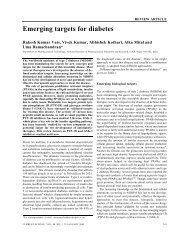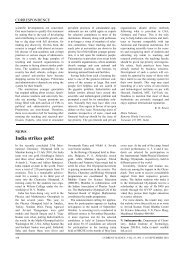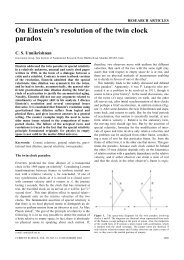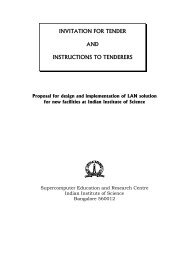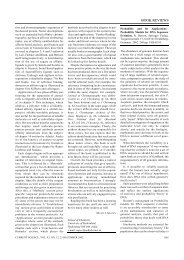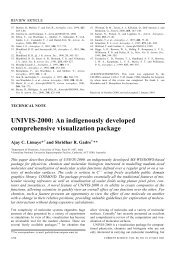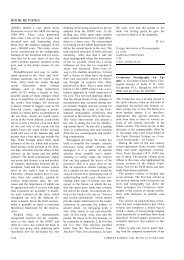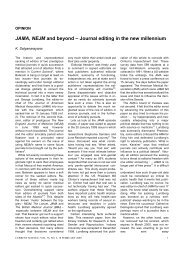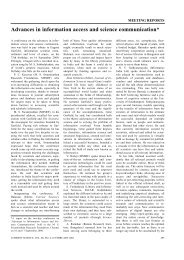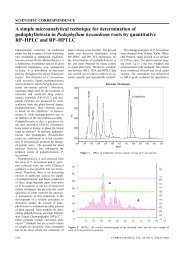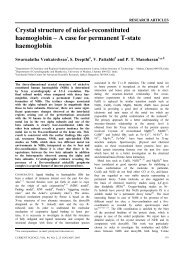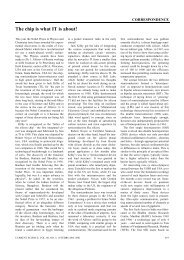Anti-tsunami and storm surge textile arrestors protecting Palk Bay - IISc
Anti-tsunami and storm surge textile arrestors protecting Palk Bay - IISc
Anti-tsunami and storm surge textile arrestors protecting Palk Bay - IISc
You also want an ePaper? Increase the reach of your titles
YUMPU automatically turns print PDFs into web optimized ePapers that Google loves.
GENERAL ARTICLES<br />
Sethusamudram ship channel macroproject:<br />
<strong>Anti</strong>-<strong>tsunami</strong> <strong>and</strong> <strong>storm</strong> <strong>surge</strong> <strong>textile</strong> <strong>arrestors</strong><br />
<strong>protecting</strong> <strong>Palk</strong> <strong>Bay</strong> (India <strong>and</strong> Sri Lanka)<br />
Richard B. Cathcart<br />
During times of periodic <strong>storm</strong> <strong>and</strong> unpredictable <strong>tsunami</strong> causing public peril in <strong>Palk</strong> <strong>Bay</strong>, <strong>textile</strong><br />
barrier (dam) technology can be employed to protect an economically important region between<br />
India <strong>and</strong> Sri Lanka. <strong>Anti</strong>-<strong>tsunami</strong> <strong>and</strong> <strong>storm</strong> <strong>surge</strong> <strong>arrestors</strong> are a new development applicable to<br />
<strong>Palk</strong> <strong>Bay</strong>, especially with the construction of the Sethusamudram Ship Channel.<br />
Keywords: Adam’s Bridge, India, <strong>Palk</strong> <strong>Bay</strong>, Sethusamudram Project, Sri Lanka.<br />
BARELY 40 km separates India <strong>and</strong> Sri Lanka at the <strong>Palk</strong><br />
Strait. Prior to the 24 December 1964 cyclone passing through<br />
the <strong>Palk</strong> <strong>Bay</strong>, the two countries had been connected by a<br />
train–ferryboat that traversed the strait between Dhanushkodi<br />
(India) <strong>and</strong> Talaimannar (Sri Lanka). A chain of<br />
limestone shoals, named ‘Adam’s Bridge’, lies within the<br />
strait, almost affording a l<strong>and</strong> connection between Mannar<br />
(Sri Lanka) <strong>and</strong> Rameswaram (India). Sri Lanka can<br />
be physically joined with India for energy generation 1<br />
<strong>and</strong> transportation purposes 2 .<br />
Much of the shoreline of western Sri Lanka bordering<br />
<strong>Palk</strong> <strong>Bay</strong> is < 10 m above present-day sea level 3 <strong>and</strong><br />
~ 50% of <strong>Palk</strong> <strong>Bay</strong> is < 10 m deep. Navigable waters of<br />
< 10 m depth constitute shallow water, where surface waves<br />
are noticeably affected by seafloor topography. Its natural<br />
northern maritime approach is restricted by the presence<br />
of Pedro Bank, while its southern ship approach is almost<br />
blocked by Adam’s Bridge, a string of low-elevation atolls.<br />
The Sumatra–Andaman earthquake (moment magnitude<br />
9.3) on 26 December 2004 <strong>and</strong> its aftershock-like companion<br />
Nias earthquake (moment magnitude 8.7) were the largest<br />
in the region for over 40 years 4 . (Sri Lanka’s west coast<br />
was struck shortly after low tide, while India’s east coast<br />
was inundated shortly following high tide.) The Sumatra–<br />
Andaman seismic event generated a 30 m <strong>tsunami</strong> that<br />
disastrously, <strong>and</strong> tragically, impacted Sri Lanka <strong>and</strong> India<br />
on the same day. The propagated <strong>tsunami</strong>, moved westwards<br />
rapidly, encompassing the periphery of the isl<strong>and</strong><br />
nation of Sri Lanka, with waves converging on <strong>Palk</strong> <strong>Bay</strong><br />
from the two sea approaches to <strong>Palk</strong> Strait. In the districts<br />
of Jaffna, Kilinochchi <strong>and</strong> Puttalam, thous<strong>and</strong>s of persons<br />
died when the <strong>tsunami</strong> swept ashore, destroying villages<br />
<strong>and</strong> damaging city waterfronts. When they returned to their<br />
Richard B. Cathcart is in the Geographos, 1300 West Olive Avenue,<br />
Suite M, Burbank, California 91506-2225, USA.<br />
e-mail: rbcathcart@charter.net<br />
1474<br />
means of making a living, the local fishermen from India<br />
<strong>and</strong> Sri Lanka subsequently discovered that nearby fishing<br />
grounds in <strong>Palk</strong> <strong>Bay</strong> <strong>and</strong> elsewhere had been drastically<br />
altered by <strong>tsunami</strong>-shifted seafloor sediments. Cathcart had<br />
warned strongly, during 2003, of the potential of dangerous<br />
future <strong>tsunami</strong>s entering <strong>Palk</strong> Strait, affecting any kind of<br />
natural or anthropogenic fixed physical feature in the <strong>Palk</strong><br />
Strait linking India <strong>and</strong> Sri Lanka <strong>and</strong>, as well, noted the<br />
marked impact of the infamous 24 December 1964 cyclone<br />
that traced (from east to west) the route of Adam’s Bridge,<br />
pummelling <strong>Palk</strong> <strong>Bay</strong>’s surface <strong>and</strong> mainl<strong>and</strong> with winds<br />
of up to 270 kph <strong>and</strong> generating within the <strong>Palk</strong> <strong>Bay</strong> an<br />
estimated <strong>storm</strong> <strong>surge</strong> of ~ 6 m near Pamban.<br />
There are a number of reported instances where deliberate<br />
alterations, such as commercial <strong>and</strong> residential beach alterations,<br />
of the India–Sri Lanka coast modified the run-up<br />
behaviour of the 26 December 2004 <strong>tsunami</strong>. The unwise<br />
destruction of mangroves on l<strong>and</strong> 5 , <strong>and</strong> long-term offshore<br />
coral mining, allowed greater <strong>tsunami</strong> penetration than<br />
would otherwise have probably taken place 6 . Post-<strong>tsunami</strong><br />
recovery <strong>and</strong> assistance assessments by geologic <strong>and</strong><br />
geomorphologic experts produced some surprises. For<br />
example, India’s Buckingham Canal (also known as National<br />
Waterway #4), which was completed in 1878, shielded<br />
many people there from a significant part of the <strong>tsunami</strong>’s<br />
onslaught 7 ; on its sunken barrier–<strong>storm</strong> water drain <strong>tsunami</strong><br />
run-up wave macro-engineering model, the seashoreparalleling<br />
An<strong>and</strong>a Victoria Marth<strong>and</strong>am Canal (National<br />
Waterway # 3), first made operational in 1860, may also<br />
have important additional 21st century uses not previously<br />
contemplated by its 19th century planners! Canals such as the<br />
Mississippi River Gulf Outlet-Industrial Canal that penetrate<br />
l<strong>and</strong> perpendicular to the coast can have dire consequences,<br />
as was observed during the <strong>storm</strong> <strong>and</strong> tidal <strong>surge</strong><br />
events accompanying hurricane Katrina of 29 August 2005<br />
at New Orleans, USA.<br />
Ravilious 8 disclosed the gist of Schuiling’s macroengineering<br />
concept for raising the level of the Adam’s<br />
CURRENT SCIENCE, VOL. 91, NO. 11, 10 DECEMBER 2006
GENERAL ARTICLES<br />
Bridge atolls by creating an artificial stone (gypsum) by<br />
geochemical conversion of a natural stone, the atollunderlying<br />
Jaffna Limestone 9 . Intact limestone, when slowly<br />
injected with sulphuric acid, a common factory waste, swells<br />
by ~ 50%, becoming gypsum; a macro-engineering project<br />
based on Schuiling’s concept could lift the atolls through<br />
gradual <strong>and</strong> unseen underground expansion of rock. Slow<br />
upheaval of Adam’s Bridge by utilization of Schuiling’s<br />
intentional ‘geochemical macro-engineering’ could create<br />
an elevated peninsula-like oceanographic barrier. Both rock<br />
types are quite capable of becoming reliable foundation<br />
material for any kind of major construction affecting<br />
Adam’s Bridge, such as the future installation of wind <strong>and</strong><br />
hydro turbines <strong>and</strong> a trans-<strong>Palk</strong> Strait railway or highway.<br />
A <strong>Palk</strong> Strait Power Station, affixed to many bridgeconnected<br />
atolls at Adam’s Bridge, <strong>and</strong> extending ~ 32 km<br />
end-to-end, would have to endure powerful Indian Ocean<br />
<strong>storm</strong>s <strong>and</strong> future infrequent <strong>tsunami</strong> emanating from the<br />
vicinity of Indonesia. The maximum vertical load for<br />
Cathcart’s proposed wind <strong>and</strong> hydro turbines is small<br />
relative to the maximum horizontal load applied by the<br />
overturning moment on the potential foundation materials.<br />
In other words, the mechanical integrity of the finished<br />
facility would not be determined by the structures imposed<br />
on the macroproject site but, rather, by the significantly<br />
homogenous <strong>and</strong> weaker natural <strong>and</strong> artificial<br />
substrates upon which the valuable, mostly metallic installation<br />
rests. Normal wind <strong>and</strong> wave loads fluctuate widely,<br />
sometimes cyclically (tides). Wind turbine blades are<br />
normally fluttered during adverse meteorological conditions,<br />
<strong>and</strong> normal tidal currents are not powerful enough to<br />
cause any serious operational problems. Wind, which is<br />
~ 25% of the normal horizontal load, may sometimes cause<br />
~ 75% of the overturning moment on such structures. Future<br />
impacts by high <strong>tsunami</strong> generated near Indonesia, probably<br />
mitigated somewhat by a real-time Indian Ocean Tsunami<br />
Warning System 10 , may permit timely adaptations<br />
of far-distant infrastructure to prevent damage <strong>and</strong> to ensure<br />
unfaltering telecommunication warnings to the people<br />
of Sri Lanka <strong>and</strong> India, as well as those in other<br />
countries bordering the Indian Ocean.<br />
In addition to the possibility of using Schuiling’s<br />
speculative geochemical atoll uplift technique, there is the<br />
possibility of using dredge spoil from the Sethusamudram<br />
Ship Channel Project (SSCP) to raise the topography of<br />
Adam’s Bridge <strong>and</strong> other places where such deposition<br />
would prove beneficial to commercial, military <strong>and</strong> civilian<br />
interests 11 . Work commenced on the SSCP during July<br />
2005 <strong>and</strong> is slated for completion by November 2008; the<br />
SSCP is subject to <strong>tsunami</strong> as well as tidal <strong>and</strong> cyclone<br />
<strong>storm</strong> <strong>surge</strong>s 12 . The actual environmental impact of the<br />
SSCP will be discovered as the SSCP is excavated – two<br />
notable on-site oceanographic experts, Rajendran 13 <strong>and</strong><br />
Ramesh 14 , have stated their forebodings concerning postexcavation<br />
sedimentation via local currents <strong>and</strong> cyclonegenerated<br />
<strong>storm</strong> waves as well as infrequent <strong>tsunami</strong>s.<br />
Both ends of the SSCP, <strong>and</strong> ships transiting the SSCP,<br />
could be protected from <strong>tsunami</strong> event-processes by an<br />
expensive mobile <strong>storm</strong> <strong>surge</strong> dam such as the floating<br />
steel Maeslant Barrier for the Nieuwe Waterweg (New<br />
Waterway) 15 , constructed by The Netherl<strong>and</strong>s during<br />
1990–97. The Maeslant Barrier cost is estimated at<br />
2005USA$598,000,000. Less monetarily costly means of<br />
SSCP physical protection for the watery border region<br />
dividing India <strong>and</strong> Sri Lanka has become available owing<br />
to the recent R&D progress of materials science 16 .<br />
A mainly metallic 12 km-long floating bridge spanning<br />
the Strait of Gibraltar 17 has been designed by Eugene Tsui,<br />
which would rely on ordinary braided steel cables <strong>and</strong><br />
massive concrete l<strong>and</strong>-based anchorages, just like those<br />
used by suspension bridges 18 . Christo created an aerial<br />
artwork 19 , ‘Valley Curtain, Rifle, Colorado, 1970–1972’<br />
which required catenaries from which was suspended an<br />
international orange-coloured air flow-interrupting <strong>textile</strong><br />
curtain 20 . Harris (1915–98) macro-engineered ‘valley curtain’.<br />
Very strong, securely anchored support cables <strong>and</strong> impervious<br />
suspended technical <strong>textile</strong> membranes are the essential<br />
components of the proposed <strong>Anti</strong>-Tsunami <strong>and</strong> Storm<br />
Surge Textile Arrestor (ATSSTA) macroproject proposal.<br />
Application of advanced technical <strong>textile</strong>s <strong>and</strong> superropes<br />
composed mainly of carbon nanotubes could permit<br />
safe emplacement <strong>and</strong> use of a pontoon bridge spanning<br />
the Strait of Gibraltar. Such a bridge would resemble the<br />
span used by Xerxes in 480 BC to support his troops as they<br />
crossed the Hellespont! Braided or str<strong>and</strong>ed super-ropes<br />
could stabilize a post-tensioned pontoon bridge in a fixed<br />
geographical alignment for a long period, especially in a<br />
nearly constant 1 m/s eastward surface layer sea water<br />
flow. ATSSTA will function much as the floating Maeslant<br />
Barrier of the Netherl<strong>and</strong>s with multiple discrete anti-<br />
ATSSTA installations designed to block the ends of the<br />
completed SSCP, stopping any <strong>tsunami</strong> entering the <strong>Palk</strong><br />
<strong>Bay</strong> <strong>and</strong> its environs <strong>and</strong> therefore, also halting the natural<br />
redistribution of sediment within the SSCP <strong>and</strong> <strong>Palk</strong><br />
<strong>Bay</strong>. When not in use during weather <strong>and</strong> earthquake<br />
emergencies, the ATSSTA will sit on the seafloor between<br />
atolls like the air-raised gates of the new dam soon<br />
to guard the sea approaches to Venice, Italy from forecasted<br />
<strong>storm</strong>s <strong>and</strong> predicted tidal <strong>surge</strong>s coming from the<br />
Adriatic Sea. ATSSTA, however, will have to be lifted by<br />
powered windlasses located on appropriately sited Adam’s<br />
Bridge atolls built up with selected enhancing deposits of<br />
SSCP dredge spoil <strong>and</strong> the mainl<strong>and</strong> (of India <strong>and</strong> Sri<br />
Lanka) – hence, the vital need for an uncompromisingly<br />
accurate Indian Ocean <strong>tsunami</strong> warning system. At urban<br />
waterfronts, where highly valuable port facilities must be<br />
protected, floating watergates such as those invented by<br />
Johhann van de Noort 21 , could be installed as needed or<br />
desired by the people of Sri Lanka <strong>and</strong> India.<br />
The ultimate hydrostatic head supported by a <strong>textile</strong><br />
(woven or non-woven) is the measure of the resistance to<br />
the passage of sea water through the membrane material;<br />
CURRENT SCIENCE, VOL. 91, NO. 11, 10 DECEMBER 2006 1475
GENERAL ARTICLES<br />
the st<strong>and</strong>ard applicable for determining imperviousness to<br />
sea water is the hydrostatic pressure test made in <strong>textile</strong><br />
factories. Several international organizations, as well as<br />
many national <strong>textile</strong> regulatory agencies generally accept<br />
the height of a seawater column (given in metric units of<br />
distance) as the appropriate validation of a test method<br />
primarily intended for dense fabrics <strong>and</strong> films. (Waterproof<br />
<strong>and</strong> watertight are synonyms in this ATSSTA macroproject<br />
proposal.) In the past, resistance to sea water penetration<br />
(in ship sails <strong>and</strong> cargo compartment hatch-covers)<br />
has been technically achieved by coating woven <strong>textile</strong>s<br />
with various waterproofing materials; watertight <strong>textile</strong>s<br />
can now be achieved by dense weaving of strong fibres.<br />
Multi-axial, multi-ply <strong>textile</strong>s are bonded in a loop system<br />
consisting of one or more yarn layers stretched in parallel;<br />
yarn layers can have different spatial orientations <strong>and</strong><br />
different yarn densities. The combination of multi-directional<br />
fibre layers has been proved by scientific laboratories<br />
<strong>and</strong> commercial factory testing to be remarkably capable<br />
of distributing extraordinarily high strain forces; multiaxial<br />
multi-ply <strong>textile</strong> structures are dimensionally stable<br />
in any direction <strong>and</strong> exhibit isotropic distribution of stress<br />
forces with uniform strain behaviour. Such validated materials<br />
will work well in tension membrane water-retaining<br />
chamber gates of single or multi-level ship-locks 22 .<br />
It is proposed that the ATSSTA be fabricated of<br />
KEVLAR (29, 49, or 149) – since 1971 KEVLAR in all its<br />
commercial products is a trade-name for Dupont’s aromatic<br />
polyamides – with a tensile strength of > 3 Gpa <strong>and</strong> cheaply<br />
mass-produced CARBON NANOTUBE with a tensile<br />
strength of ~ 16 Gpa 23 . (The ratio of producible CARBON<br />
NANOTUBE tensile strength to KEVLAR tensile<br />
strength is approximately 16/3, or about 5.) Such extremely<br />
strong materials, which are becoming rapidly cheaper to<br />
produce <strong>and</strong> are able to perform as unitary form-active<br />
structures ought to be investigated for use in the proposed<br />
ATSSTA macroproject. The maximum force exerted on a<br />
square metre of KEVLAR by a 2 m-high <strong>tsunami</strong> should<br />
be ~ 2 N/m 2 . The characteristic strength of a structural<br />
<strong>textile</strong> or film must have a low probability (~ 5%) of not<br />
being reached during the lifetime of the material’s use in<br />
the ATSSTA <strong>and</strong> the characteristic load must not have more<br />
than a 5% probability of being exceeded during the design<br />
life of the ATSSTA. KEVLAR has a failure strain of<br />
> 3%, while the failure strain for CARBON NANOTUBE<br />
is < 6%. Possibly embedded fibre-optic electronics – detectors,<br />
reporters <strong>and</strong> automated alarm actuators – ought to<br />
be used to monitor in real-time the stored CARBON<br />
NANOTUBE super-ropes <strong>and</strong> KEVLAR curtains as well<br />
as the drape of the fully deployed ATSSTA. Of course,<br />
human monitors will be situated in distant or sequestered<br />
flood-proof offices <strong>and</strong> housing, safe from all injurious<br />
<strong>tsunami</strong> beach run-up effects.<br />
Planners of the SSCP – with an estimated final SSCP<br />
total cost of 2005USA$500,000,000 – <strong>and</strong> the commercial<br />
<strong>and</strong> naval interests of India <strong>and</strong> Sri Lanka involved with the<br />
macroproject planning, actual building, <strong>and</strong> operational<br />
management may desire to consider multiple installations<br />
of ATSSTA around the <strong>Palk</strong> Strait to safeguard people<br />
<strong>and</strong> property of both India <strong>and</strong> Sri Lanka. For example, at<br />
several acute bends in the SSCP that will tend to sediment<br />
quickly, if only from ship propeller-stirred sea water currents,<br />
special underwater ATSSTA-like screens could<br />
forestall such long-term hazard to navigation. Unlike the<br />
SSCP, ATSSTA can be adjusted as to its optimal location<br />
through field experimentation both during <strong>and</strong> after installation.<br />
It can accommodate future climate change. In<br />
addition, there may be a real need to install at least one<br />
ATSSTA on Thail<strong>and</strong>’s west coast to guard the entrance<br />
for a proposed Kra Canal through Thail<strong>and</strong> which means<br />
India <strong>and</strong> Sri Lanka may have a regional marketing opportunity.<br />
There is a future possibility for ATSSTA manufactures<br />
at the Strait of Gibraltar, where a barrier made with<br />
<strong>textile</strong>s could afford Mediterranean Sea Basin nations a means<br />
to prevent flooding of coastal cities such as Venice, Italy,<br />
by a postulated global sea-level rise.<br />
1. Cathcart, R. B., Curr. Sci., 2003, 85, 430–431.<br />
2. Cathcart, R. B., Curr. Sci., 2004, 87, 849–850.<br />
3. GOTO http://photojournal.jpl.nasa.gov/catalog/PIA06670.<br />
4. Geist, E. I., Earth, Planets Space, 2006, 58, 185–193.<br />
5. Dittmar, T., Global Biogeochem. Cycles, 2006, 20, GB101210.<br />
6. Kumaraguru, A. K., Curr. Sci., 2005, 89, 1729–1741.<br />
7. Rao, B. R., Curr. Sci., 2005, 89, 12–13.<br />
8. Ravilious, K., New Scientist, 2004, 184, 38–41.<br />
9. Schuiling, R. D., Curr. Sci., 2004, 86, 1351–1352.<br />
10. Lomnitz, C., EOS, Trans. Am. Geophys. Union, 2005, 86, 65.<br />
11. Seralathan, P., Curr. Sci., 2006, 90, 146–147.<br />
12. Kathal, P. K., Curr. Sci., 2005, 89, 1082–1083.<br />
13. Rajendran, C. P., J. Geol. Soc. India, 2005, 66, 367–370.<br />
14. Ramesh, R., Curr. Sci., 2005, 88, 536–537.<br />
15. GOTO http://www.deltawerken.com/Maesl<strong>and</strong>-barrier/330.html.<br />
16. Brownell, B., Transmaterial: A Catalogue of Materials that Redefine<br />
our Physical Environment, Princeton University Press,<br />
Princeton, USA, 2006.<br />
17. GOTO http://www.tdrinc.com/gibraltar.htm.<br />
18. Anon., Pop. Mech., 2004, 181, 26.<br />
19. GOTO http://christojeanneclaude.net/vc.httml.<br />
20. Vaizey, M., CHRISTO, Rizzoli, NY, 1990, pp. 74–79.<br />
21. GOTO http://www.noort-innovations.nl/SCWworking.html.<br />
22. Cullen, M. N., Trans. Built Environ., 2005, 79, 427–436.<br />
23. Dumitria, T, Hua, M. <strong>and</strong> Yakobson, B. L., Proc. Natl. Acad. Sci.<br />
USA, 2006, 103, 6105–6109.<br />
Received 27 March 2006; revised accepted 3 July 2006<br />
1476<br />
CURRENT SCIENCE, VOL. 91, NO. 11, 10 DECEMBER 2006



